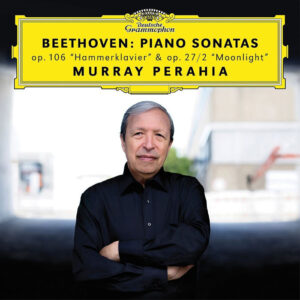Murray Perahia’s concert performances of Beethoven’s Piano Sonata No. 29 Op. 106, the so-called “Hammerklavier”, generated considerable attention during his 2015-2016 season. He subsequently recorded the work in November 2016. The pianist couples it with Beethoven’s Moonlight Sonata (Op. 27 No. 2), placing the latter second, which seems anticlimactic. So I’ll discuss the Moonlight first. Initially Perahia’s interpretation of the famous Adagio sostenuto seems, for lack of a better word, “normal”, with no unusual features like Solomon’s super-slow tempo or András Schiff’s iconoclastic pedaling. Closer scrutiny, though, reveals many well-considered gradations in dynamics and sonority.
Perahia’s Allegretto is slightly measured and held back, yet with a degree of finger independence that evokes a string quartet more than a concert grand. Rather than speed through the finale come hell or high water, Perahia intensifies the music’s “agitato” profile through balancing textures and articulating rapid figurations with purposeful precision, saving orchestral strength and the sustain pedal’s fullest impact for the main climax toward the movement’s end.
Fine as it is, Perahia’s Moonlight proves nowhere near so striking, so interesting, nor so memorable as his Hammerklavier. His remarkable interpretation leaves no small detail unconsidered, yet still conveys tremendous vibrancy, forward motion, and a sense of controlled freedom. What is more, the pianist’s sophisticated balancing of contrapuntal textures and harmonic pointing never sounds the least bit forced, contrived or self-aware, while his 69-year-old fingers operate at unambiguously full capacity as regards speed, accuracy, suppleness and flexibility.
The first movement’s lyrical cadences fall easily on the ear as they prepare you for what’s ahead, while the development section fughetta’s driving momentum is tempered by Perahia’s care in scaling the dynamics. As a consequence, the upward chains of broken sixths and fifths between the hands right before the recapitulation achieve a palpable climax without the need for underlining or slowing down on the pianist’s part. Here Perahia opts for the conventional A-natural that Rudolf Serkin, Wilhelm Kempff, and Alfred Brendel observed, although I prefer the controversial “inspired misprint” A-sharp vis-à-vis Artur Schnabel, Solomon, Claudio Arrau, and Igor Levit.
Perahia may not throw the Scherzo away with Peter Serkin’s offhanded insouciance, yet he accounts for every note in the opening measures’ sprung chords; and notice how the pianist generates phrases in the Trio’s cross-rhythmic phrases through color and touch alone, with no extra tenuto or breath mark to be found. Strong left-hand underpinning and clear voice leading provide not so much an anchor as an emotional foil to the Adagio sostenuto’s elaborate right-hand cantabiles. While many pianists pedal through the rests in the fourth-movement introduction, Perahia trusts Beethoven’s silences, yet dramatizes them by coloring the surrounding notes with the utmost specificity. The pianist sustains the notorious fugal finale with subtle characterizations, such as his holding back ever so slightly when the theme first appears in retrograde, or providing strong linear contouring throughout the lyrical D major section. In concert Perahia’s unsubtle accelerating just before the final measures bothered me; happily he doesn’t do so here!
The sonic ambience pretty much replicates the ample splendor of Perahia’s sound as experienced from a choice front row seat in a concert hall. In short, Perahia’s Hammerklavier timelessly fuses the personal and universal in a release that easily takes its place among the catalog’s greatest versions. It’s a recording that’s built to last.
































